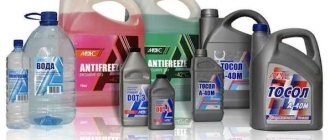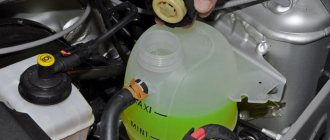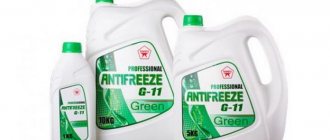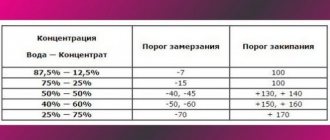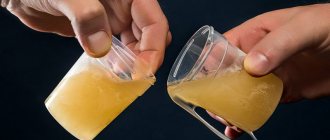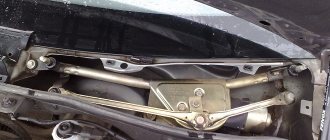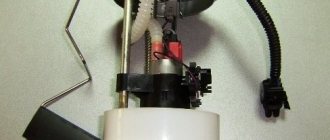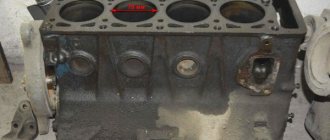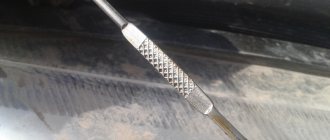Antifreeze, or antifreeze, is a liquid that is poured into the expansion tank of a car's cooling system. Literally translated into Russian, the word “antifreeze” means “anti-freeze.” This liquid does not solidify at subzero temperatures, cools the engine during operation and protects its elements from corrosion.
The composition of factory antifreezes includes ethylene glycol, propylene glycol, glycerin mixtures, monohydric alcohols, water and other substances. Sometimes flavorings are added to them.
Some car owners make antifreeze at home and note that it is not at all difficult. Look for the “recipe” further in the article.
But first, let’s figure out what is called antifreeze and what is antifreeze, and is there a difference between these liquids.
What is the composition of winter washer fluid for a car?
Regular operation of the machine in winter requires constant replenishment of a special mixture, which entails significant costs.
The second reason that can push a car enthusiast to make his own “anti-freeze” is the unsatisfactory quality of the industrial product. A solution that freezes at low temperatures can cause cracks in the tank and hose, as well as failure of the pump. Before making a wash at home , it’s a good idea to familiarize yourself with the main ingredients that are used in the factory composition. Structurally, the complex of main components looks like this:
- Surfactants.
- Water.
- Alcohol.
- Flavoring.
The domestic industry uses monohydric alcohol – isopropanol – as an alcohol-containing substance. Products based on it are inexpensive, but have a significant drawback, which is the presence of an extraneous odor. To get rid of it, manufacturers of antifreeze emulsions add flavorings to them, although judging by the reviews of motorists, this is of little use.
The best thermal modifier, which is part of the washer fluid, is considered to be ethyl alcohol, in simple terms – “food grade”. However, excise taxes on this product in Russia are so high that manufacturers have abandoned its use. Sometimes you can find “top” ethanol-based mixtures, but the price for a five-liter canister will immediately discourage you from purchasing it.
Another alcohol solution - methanol, is cheap, does not freeze down to -98°C and has no pronounced odor. It is quite widely used in EU countries, but in Russia it has been banned since 2007 due to “certain inclinations of certain segments of the population”, as well as the harmfulness of its fumes.
Thus, it turns out that the choice is not very large. On the one hand, isopropyl mixtures cost 400-700 rubles in dealer stores, and on the other, methanol emulsions cost 50-200 rubles on the highway. In the first case, the integrity of the rubber bands and the solidification threshold are guaranteed, but you have to breathe a specific “lemon” or “pine”. In the second option there will be no smell, since the solution is methanol, however, there are no guarantees. This is why many car owners “open their own production” of winter windshield fluid, and, believe me, there is nothing complicated about this technology. But the benefits are obvious.
The idea of heating antifreeze for a diesel car: basic provisions and nuances
The essence of the solution
Modern diesel engines are distinguished by the fact that they use heating of antifreeze with glow plugs in a certain temperature range. The main goal is to extend the life of the particulate filter. When cold, the fuel does not burn completely and soot is formed, which settles on the honeycomb of the filter element. As it warms up, its concentration in the exhaust gases decreases.
Structurally, the idea is presented in the form of a metal block into which special glow plugs are screwed. The housing is a component of the cooling system - a “coolant” circulates through its internal cavity. Most often, the assembly unit is integrated into the cylinder head.
The spark plugs are not always active: the ECU specifies a maximum coolant temperature below which the heater starts working. The system operates in fully automatic mode - when the upper thermal limit (60-75°C) is reached, the heater is deactivated.
Requirements
Let’s say right away that the installation should not be regarded as pre-heating of the coolant. This is not Webasto or Eberspächer! The device operates exclusively when the engine is running - the liquid must circulate through the internal channel.
Based on the operating features of the factory coolant heater, you can create a list of requirements that must be met when assembling and installing a home-made product:
- Switching on should occur after starting the engine.
- Automatic control is carried out by a temperature sensor, which opens the power circuit when it reaches 60-75°C and supplies current to the spark plugs at temperatures below 60-75°C.
- Duplicate manual channel for selecting the operating mode.
Method 1: how to make a winter wash from isopropyl alcohol at home in 5 minutes?
To prepare the emulsion you need to stock up on the following components:
- Isopropyl alcohol.
- Dishwashing detergent (chlorine-free).
- Water.
Important!
Due to the poor quality of tap water, it must be passed through a regular filter. Otherwise, such “delights” as rust, white coating and streaks on the glass are guaranteed. The best option would be to use distilled water.
Before making anti-freeze at home , let's decide on the container in which the ingredients will be mixed - traditionally this is a five-liter canister or a plastic bottle. From this we begin to “dance”:
- pour two liters of water into a container;
- add two liters of isopropyl;
- add one capful of detergent;
- close the lid of the canister and shake the mixture thoroughly.
The above recipe with a 50/50 concentration is quite suitable for cold weather down to -20°C. However, those who wish can prepare the solution specifically for certain weather conditions. In this case, there is a rule - the lower the temperature, the more alcohol needs to be added. Table of percentages to help:
| Alcohol concentration, V% | Alcohol concentration, weight % | Freezing temperature, °C |
| 10 | 8 | -4 |
| 20 | 17 | -7 |
| 30 | 26 | -15 |
| 40 | 34 | -18 |
| 50 | 44 | -21 |
| 60 | 54 | -23 |
| 70 | 65 | -29 |
| 80 | 76 | -37 |
| 90 | 88 | -57 |
| 100 | 100 | -90 |
Mixing
As a rule, concentrate manufacturers indicate on canisters how and in what proportions the composition needs to be diluted. Here everything directly depends on the temperature thresholds of the climate zone. For regions located in the middle zone, antifreeze with an indicator of -25 degrees is enough; for colder zones, at least -40 degrees will be required.
To prepare antifreeze with an indicator of -25°, concentrate and water must be mixed in a ratio of 2:3 (two liters of concentrated coolant and three liters of water). At the same time, the upper threshold drops from +196 degrees to approximately +130, +140, which is more than enough for many cars.
To prepare coolant with an indicator of -40°–45°, it is necessary to maintain a 1:1 ratio. In other words, the proportion of concentrate and water must be equal. The upper limit will be about 150-160°.
It should also be noted that there is no need to greatly dilute the concentrate with water, as this reduces the characteristics of not only freezing, but also overheating. For example, if you make a solution from one part of concentrate and four parts of water, you will get a lower limit of -15 degrees, and an upper limit of +100.
Method 2: how to make high-quality anti-freeze from ethyl alcohol at home?
Some car owners do not like anti-freeze mixtures based on isopropyl alcohol, either legally produced or homemade. They are mainly irritated by a pungent odor that cannot be gotten rid of even by turning on recirculation. In such cases, a homemade ethanol-based mixture can help.
- Ethanol.
- Ethylene glycol or concentrated antifreeze.
- Essential oil.
- Distilled water.
Many who are interested in this method of how to make a winter wash at home will be surprised by the presence of ethylene glycol in the list. The explanation here is simple - in frosty weather, alcohol evaporates on the glass first, and the water remains and freezes. And ethylene glycol, soluble in water and alcohol, reduces the volatility of the solution.
On average, the solution is prepared in a ratio of 1:2, where 1 part is alcohol and 2 is water. Depending on the temperature at which you plan to use, the composition can be adjusted. The scheme for adding alcohol per 5-liter canister is as follows:
The second step is to add ethylene glycol to the container at the rate of 15 cm³ for each degree below zero. For example, for -20°C you need to add 300 grams of glycol.
Important!
Be careful when working with ethylene glycol or antifreeze because these are toxic substances. Anyone who has a hypertrophied fear of everything harmful is recommended to replace them with propylene glycol. It is somewhat more expensive, but is not toxic and is found in the form of household antifreeze.
The third stage is to get rid of the vodka smell; those who are not bothered by it can skip this step. Here we could use food flavorings or gel “scent”, but we only need everything natural. Therefore, we will buy a bottle of essential oil with the desired aroma for 100 rubles - it should be enough for the whole winter. Add 8-10 drops of oil to the canister and add water to the full volume, then mix the mixture thoroughly.
For those who are interested in the topic of how to make anti-freeze from ethyl alcohol at home, it will be useful to know one detail. To increase cleaning properties, you can add one tablespoon of washing powder. The resulting product is not cheap (about 250-300 rubles), but its quality is impeccable.
What you will need
Antifreeze is responsible not only for cooling the engine, but also maintains its normal performance, while eliminating corrosion and protecting against rust particles with the help of special additives contained in the composition. If you dilute the concentrate with tap water, there is a risk of not only reducing the effectiveness of the additives, but also adding microelements to the liquid that negatively affect engine performance and cause corrosion.
In addition, compounds of chlorine, magnesium, calcium and other chemical elements found in tap water clog small channels in the engine, thereby reducing the effectiveness of the coolant.
From the above it follows that to make a mixture from antifreeze concentrate, you need not only a high-quality concentrate, but also distilled water that does not contain impurities.
Alternative: what else can you use to make your own anti-freeze liquid for glass?
Bottles with a blue composition, which are often found in markets or on highways, are mostly made from methanol, which is why they are cheap. The quality of this product, although illegal, is quite acceptable. But recently they began to “encrypt” it as legal, adding isopropanol for smell. And this is unacceptable for many.
If the two methods discussed above do not suit you, then there are alternative options.
- Using methanol
- 1 part methyl alcohol is mixed with 9 parts water.
To improve glass cleaning, you can add a tablespoon of dishwashing detergent. During the cooking process, it is important to prevent methanol from getting into the respiratory tract and eyes! - Using vinegar
- the component is mixed with water in a 1:1 ratio. It is important to know that this emulsion is used at temperatures above -10°C, otherwise the “aroma” of vinegar will be present in the cabin. - Using ammonia
, the solution is prepared in proportions of 1:3, where 1 part is ammonia and 3 is water. When mixing, do not allow foam to form. The mixture is not suitable at ambient temperatures above -10°C. The question arises: how to make a winter wash at home so that if this value is exceeded, the solution does not harden? It's simple - add vinegar in an amount of 10% of the total weight.
Antifreeze - technical specifications and purchase rules
Once at the counter in an auto store, most are perplexed as to which color of antifreeze is better, because they were not prepared for such variety. The answer is not that complicated! This parameter does not affect any quality characteristics; it is just a dye added by the manufacturer. Its main purpose is to differentiate brands and allow them to be mixed, for example, in model “40” the liquid is often blue, and “65” is red. It is also used for safety, since without dye, antifreeze has a transparent white color.
The boiling point of antifreeze usually lies in the range of 104–112 degrees Celsius; as for imported antifreeze manufacturers, it reaches 120–130. When purchasing, one of the ways to check quality is to measure the density; a good indicator is the limit from 1.060 to 1.090 g/cm 3 . Before going to the store, you need to determine what brand of coolant is in your car, and to do this, you should refer to the owner's manual. You can also find application rules there.
conclusions
When making your own antifreeze liquid, it is highly advisable to use distilled water. This measure will protect the nozzles and washer pump from deposits of mineral salts.
The most effective are mixtures based on isopropyl or ethyl alcohol when produced in-house. Although the total cost of our own product is somewhat high, its quality is an order of magnitude higher than its factory counterparts.
It is imperative to check the resistance of the liquid to low temperatures by testing a small amount of the finished emulsion. In case of freezing or thickening, you need to boost its properties by adding an alcohol-containing substance. Labeled canisters must be stored out of the reach of children and animals.
How to create the above items outside the plant/factory
The cheapest, most widespread and still used antifreeze is water. Any kind.
A soldier has eternity ahead, don’t confuse it with old age
remove the thermostat, insulate the radiator, antifreeze is ready.
Why insulate when you need to cool it on the contrary?
if winter intercepts in the radiator. look at the trucks in winter the muzzle is closed
And if in the summer and the temperature is more than 0 degrees
Antifreeze is ethylene glycol, propylene glycol, glycerin, monohydric alcohols and mixtures of other substances with water. That's what the wiki says. We need to build on this
What do you think of biologically degradable oils that are made from garbage, or rather from plants that are pressed, etc., and is there ANY type of oil (except castor oil) that can be made in relatively home conditions if you have a laboratory and plants and devices for pressing and electricity?
Plants are needed in large quantities.
What exactly is the problem, then? Oil – any vegetable oil. Antifreeze - any alcohol, and the same notorious moonshine. Or, at worst, any alcohol-containing liquid, for example Chanel No. 5 perfume
